Advertisement
Grab your lab coat. Let's get started
Welcome!
Welcome!
Create an account below to get 6 C&EN articles per month, receive newsletters and more - all free.
It seems this is your first time logging in online. Please enter the following information to continue.
As an ACS member you automatically get access to this site. All we need is few more details to create your reading experience.
Not you? Sign in with a different account.
Not you? Sign in with a different account.
ERROR 1
ERROR 1
ERROR 2
ERROR 2
ERROR 2
ERROR 2
ERROR 2
Password and Confirm password must match.
If you have an ACS member number, please enter it here so we can link this account to your membership. (optional)
ERROR 2
ACS values your privacy. By submitting your information, you are gaining access to C&EN and subscribing to our weekly newsletter. We use the information you provide to make your reading experience better, and we will never sell your data to third party members.
Electronic Materials
To upgrade quantum computers, researchers look to materials science
Scientists need to improve the basic elements of quantum circuits—qubits—to push their machines to the next level of quantum weirdness
by Katherine Bourzac
April 12, 2019
| A version of this story appeared in
Volume 97, Issue 15
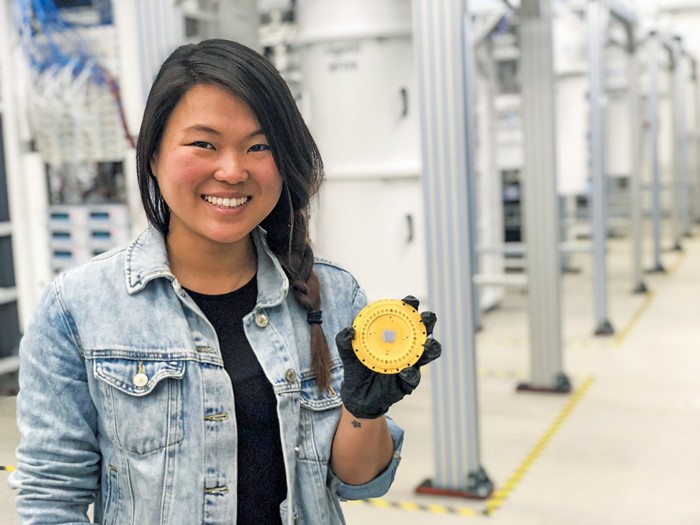
In brief
Quantum computers promise to simulate complex chemistry that can’t be modeled on conventional computers. But today’s quantum computers use error-prone hardware and don’t yet live up to this potential. So materials scientists and quantum engineers are working to improve the basic hardware element of quantum computers, called the qubit. They are developing better manufacturing recipes and control equipment for the leading technologies: superconducting qubits and trapped-ion qubits. They’re developing technologies based on that old standby, silicon. And they’re envisioning less error-prone qubits based on new quantum materials that exhibit weird effects.
As she walks around the lab of Rigetti Computing, quantum engineer Sabrina Hong strains to make her voice heard over a loud pumping noise. It’s the heartbeat of helium refrigerators cooling down the Berkeley, California–based start-up’s quantum computers. To perform optimally, these machines need to run below –273.14 °C (10 mK)—colder than outer space.
Whoosh, supercold liquid helium is pumped in. Whoosh, warmed helium is pushed out. “I love that sound,” Hong says. It means the company’s two commercial quantum computers are up and running, at the ready for customers. Rigetti and other firms in the quantum computing business, including IBM and Google, allow customers to access their machines over the cloud and perform calculations.
The pumping sound also means that the machines are ready for Hong and other engineers on the Rigetti team. She wants to improve quantum computers’ performance and would like to try out some test chips fabricated using new circuit recipes.
For decades, theoretical physicists and computer scientists have been compiling evidence that quantum computers will eventually leave our current top-of-the-line supercomputers in the dust. Among other things, they predict that quantum computers should be able to simulate complex chemical systems that conventional computers cannot. The machines, they believe, will elucidate the energetic states of magnetic materials, superconductors, and catalysts and speed up the process of developing new materials.
At this point, however, researchers have yet to use a quantum computer to solve a chemistry problem—or any problem—that a classical computer can’t tackle. So far, they’ve simulated only simple molecules. For instance, Maryland-based start-up IonQ has modeled a water molecule, and IBM has tackled beryllium hydride.
Quantum computers have been limited to simple problems because of their hardware. The basic elements of quantum circuits, called qubits (for quantum bits), are still highly error prone. Truly useful quantum computers will probably need millions of robust qubits, a far cry from the tens of qubits operating in today’s machines. And if the ones we have today are misfiring, there’s no hope of a million-qubit system calculating anything with certainty. So scientists and engineers like Hong are shouldering the responsibility of building a better qubit.
What’s a qubit, anyway?
The word qubit has two meanings, one physical and one conceptual. Physically, it refers to the individual devices that are used to carry out calculations in quantum computers. Conceptually, a qubit is like a bit in a regular computer. It’s the basic unit of data in a quantum circuit.
In classical computers, bits are represented as a 1 or a 0. Physically, this binary data system manifests in switches called transistors. When current flows through a transistor, that’s a 1, and when it doesn’t, that’s a 0. Similarly, qubits have energy states that can be represented as a 1 or a 0 when they’re measured. But until they’re measured, they are in a superposition of states—0, 1, or many places in between. And their states are connected, or entangled, with those of other qubits.
It’s because of this quantum in-between that a quantum computer could theoretically store and process a lot more information than a conventional computer, which uses a binary system. “A qubit uses quantum mechanical phenomena to do things with information you can’t otherwise do,” says Brad Blakestad, a program manager for quantum computing at the Intelligence Advanced Research Projects Activity (IARPA).
Qubits 101
You aren’t alone if you don’t completely understand qubits. Here’s a primer.
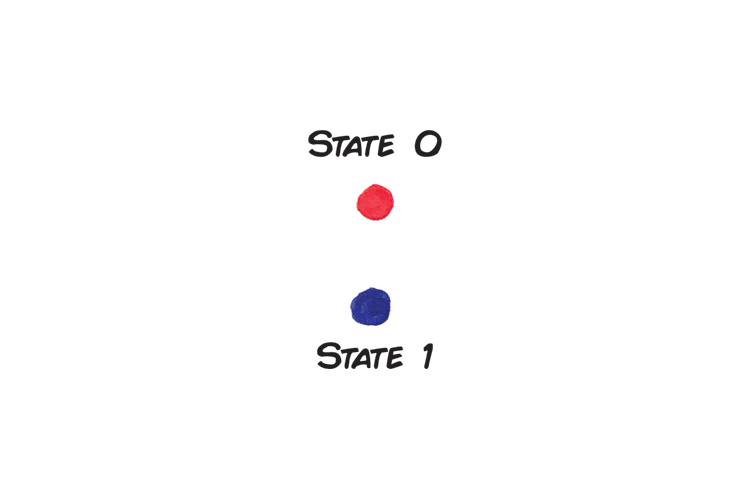
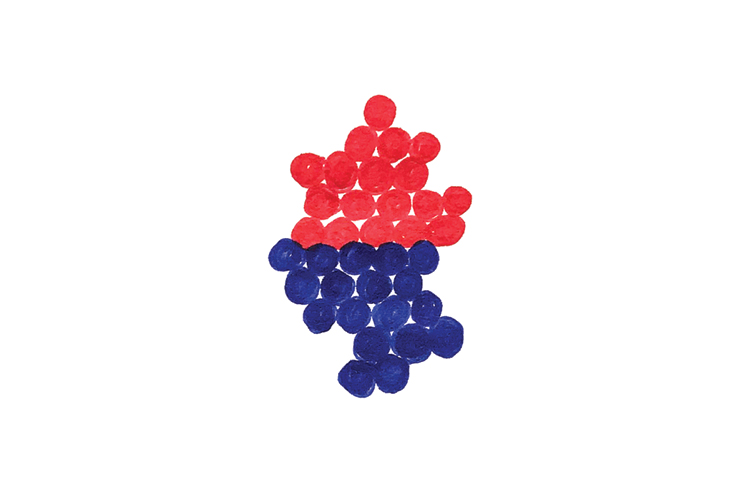
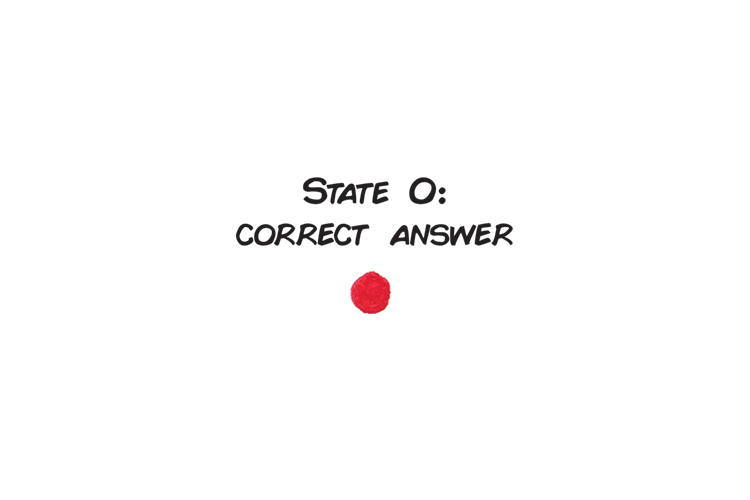

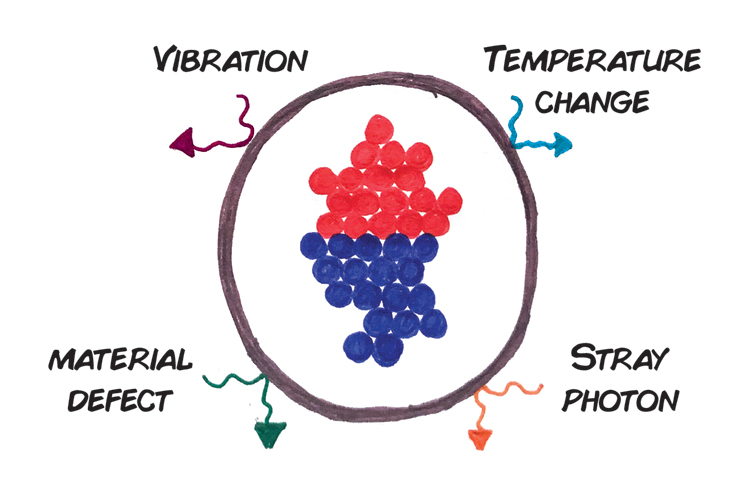
One common type of physical qubit is the nuclear spin of a trapped ion. The spin of the ion’s nucleus can be either up, which could represent 0, or down, which could represent 1. Before it’s measured, however, it could theoretically be in a multitude of spin states. Researchers use electrical fields, lasers, or other inputs to set the state of each qubit in a circuit. Then they perform some quantum logic operations using the qubits to carry out an algorithm. Finally, they measure the qubits again to find the output of the algorithm.
But the quantum states of qubits are fragile. A single stray photon, a tiny vibration, or a slight variation in temperature, and a qubit’s state can be thrown out of whack, causing it to give a wrong answer. Qubits also have a penchant for eavesdropping. They can pick up on signals intended for their neighbors and change their state.
Physical qubits are “much more sensitive to noise” than transistors in regular circuits, Blakestad says.
The ability to hold a quantum state is called coherence. The longer the coherence time, the more operations researchers can perform in a quantum circuit before resetting it, and the more sophisticated the algorithms that can be run on it. To reduce errors, quantum computers need qubits that have long coherence times. And physicists need to be able to control quantum states more tightly, with simpler electrical or optical systems than are standard today.
A quantum computer will need about 200 or so perfect qubits to perform chemical simulations that are impossible on classical computers, says Maud Vinet, an engineer with CEA-Leti, a French electronics research institute. Because qubits are so prone to error, though, these systems are likely to require redundancy, with tens or perhaps hundreds of faulty qubits doing the work of one ideal qubit that gives the right answer. These so-far-theoretical ideal qubits are often called “logical qubits” or “error-corrected qubits.”
“I can go and make 1,000 [nonideal] qubits for you tomorrow, but that’s not a useful processor,” says Jerry Chow, manager of experimental quantum computing at IBM’s Thomas J. Watson Research Center. “It doesn’t make sense to increase the number of qubits before you improve your error rates.”
Because qubits are currently error prone, scientists have a hard time figuring out whether a qubit correctly gave them a 0 state or whether it incorrectly gave them a 0 state because it was disturbed by some noise. Scientists are getting better at detecting these errors, but correcting for them is still extremely difficult, Blakestad says. He directs IARPA’s LogiQ Program, which aims to create a logical qubit and prove that error correction is possible.
Under LogiQ, four teams have been charged with demonstrating a logical qubit by 2021. (An IARPA representative said the agency does not disclose funding numbers.) Teams led by IBM and the Delft University of Technology are working on superconducting qubits, and teams led by Duke University and the University of Innsbruck are working on trapped-ion qubits. These two qubit designs have shown the most promise in these early days of quantum computing. Both are close to being able to perform a calculation that’s currently impossible for classical computers, a feat called quantum supremacy, Blakestad says.
In Europe, scientists are taking a similar approach of not putting all their eggs in a basket that holds one type of qubit. In October 2018, the European Union announced a €1 billion, 10-year Quantum Flagship initiative that will fund 20 projects in its first 3 years during a “ramp up” phase. “Here in Europe, we are funding superconducting qubits and ions on the same level,” plus basic research on other types of qubit designs, says Tommaso Calarco, director of the Institute for Complex Quantum Systems at Ulm University. It’s too early to focus research funding and industrial development on any one technology, he adds, because it’s not at all clear which will be the winner.
Blakestad agrees. What looks most promising today, he says, may have nothing to do with the technology that’s in the lead 10 years from now. “I think that’s very much still up in the air.”
Muffling the noise
“There are probably about 20 suggested ways of creating qubits for quantum computers, with varying degrees of success,” says Clarina dela Cruz, science coordinator for the Quantum Materials Initiative at the Oak Ridge National Laboratory (ORNL).
At the recent American Chemical Society Spring 2019 National Meeting in Orlando, Florida, dela Cruz described how her team uses ORNL’s neutron source, the brightest in the world, to characterize quantum materials. Because so many existing and proposed qubits store information in spin states, she says, magnetism is the most important property to study. Neutron beams can be used as a kind of microscope for studying the magnetic properties of materials.
Discovering quantum materials requires physicists, chemists, and materials scientists to work together, dela Cruz says. Materials scientists search databases for structures that match physicists’ predicted quantum materials and then seek the advice of chemists. Most of the time, she says, the chemists say something like, “That cannot be stabilized—try another element here.” Once a potential quantum material is made, researchers can use neutron-scattering experiments to study its structure and how it responds to a range of temperatures, changing magnetic and electrical fields, and other parameters. To prove that they’ve made a qubit, researchers have to extensively characterize all the possible states of their devices and figure out how to switch them with a high level of control, she adds.
“Materials science is a huge component of increasing the performance of our circuits,” says Corey Rae McRae, a quantum physicist and postdoctoral researcher at the University of Colorado Boulder and the Boulder arm of the National Institute of Standards and Technology. McRae works on superconducting qubits, which are circuits incorporating multiple devices. First, they include simple devices made from aluminum or niobium—both of which are superconducting at cryogenic temperatures. These are integrated with electron-tunneling devices made by sandwiching the same metals around insulators. Superconducting qubits can be switched between two energy levels—representing 0 and 1—with microwave pulses.
Scientists handle these types of qubits with great care to eliminate all possible sources of noise. First, they are kept extremely cold in helium refrigerators like the ones in Rigetti’s labs. And engineers use only the most delicate microwave pulses to interact with them—they typically apply only a single photon, McRae says. At these low temperatures and photon levels, one of the noisiest things is the insulating material in the device itself. Typically made of aluminum oxide, the insulator can act like an antenna, absorbing microwave pulses rather than allowing them to transmit quantum states and, in effect, muddying the information encoded in those pulses.
McRae wants to minimize the loss of these microwave pulses. She is designing chips that blow up the qubit, separating all the parts on the same wafer so that losses can be measured from each one individually. Then their individual losses can be added up. McRae and others are also using similar methods to test alternative materials.
At Rigetti, Hong and other engineers are testing how slight changes in manufacturing affect the coherence times of the company’s superconducting qubits. She says making a good interface between the underlying silicon wafer and the device’s metal layer, usually aluminum, is a particular focus. “You can almost double the coherence time” by making clean interfaces, she says. The company is also honing the control electronics used to generate and carry microwave signals to individual qubits.
Proponents of superconducting qubits like the fact that they can be created using equipment and materials already used to fabricate conventional computer chips, with few alterations. Meanwhile, researchers working on the other leading class of qubits, trapped ions, boast that their qubits don’t need to be manufactured at all: nature makes them just right. “Every ion is the same. There’s no synthesis to worry about,” says Kenneth Brown, a chemist and quantum engineer at Duke University. Brown is the leader of a $15 million National Science Foundation project to build a programmable ion-trap quantum computer. He’s also a consultant to IonQ.
Advertisement
The qubits in these devices are individual trapped ions, floating in empty space. Ion traps apply electromagnetic fields to suspend ions in a vacuum and use lasers to cool them down. Unlike a superconducting quantum computer, the entire system does not need to be extremely cold—just the individual ions. Researchers use lasers to manipulate the nuclear spin of the atom, and photodetectors to measure it. A common ion choice is the ytterbium isotope 171Yb+, whose nuclear spin is relatively impervious to magnetic fields, protecting it from noise. In one experiment by Kihwan Kim at Tsinghua University, a 171Yb+ qubit held its state for about 10 min, a record coherence time, and an eternity in the quantum world (Nat. Photonics 2017, DOI: 10.1038/s41566-017-0007-1).
The issue with trapped-ion qubits is control. It’s straightforward to load ions into a trap, but addressing them individually with a laser is difficult. According to Brown, scientists can so far individually control only 20 or 30 ion qubits at once. The necessary optics to split laser beams to greater numbers of ions, for instance, are still being developed.
Qubits at a glance
Scientists have proposed 20 or so qubit designs so far.
Here’s a guide to 4 of the most promising.
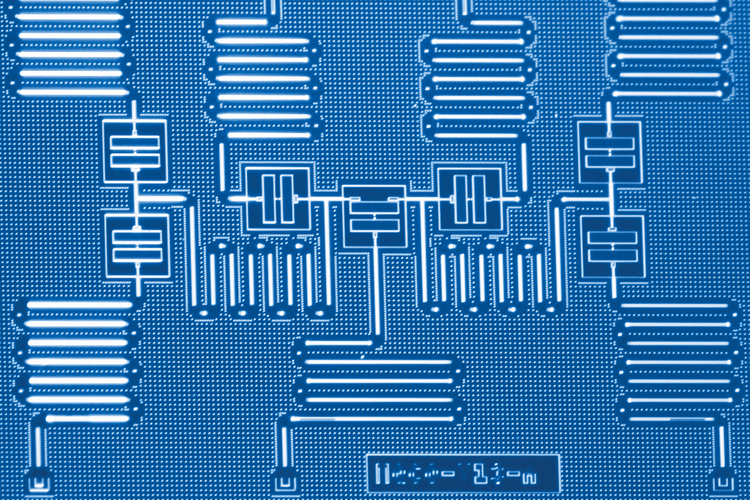
Superconducting circuits
Advantages: They can be made using conventional materials and semiconductor manufacturing equipment.
Status: Under development by Google, IBM, Intel, Rigetti Computing, and others. IBM has used the circuits to simulate beryllium hydride. Google says it has recently integrated 72 superconducting qubits to create one of the largest quantum computers to date.

Trapped ions
Advantages: Ions are made by nature, and they are less susceptible to noise and errors.
Status: Under development by IonQ, Alpine Quantum Technologies, Quantum Factory, Universal Quantum, and others. IonQ has used a trapped-ion computer to simulate water.
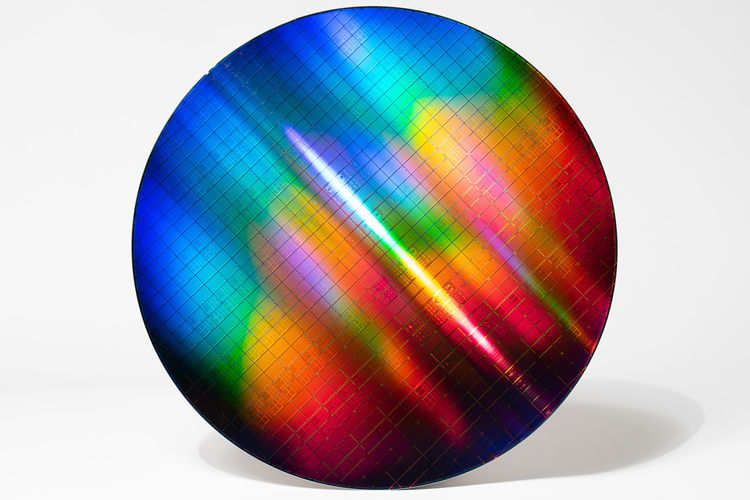
Silicon spin devices
Advantages: These devices leverage existing designs used by the semiconductor industry. Proponents see a path to scaling up to large systems of millions of qubits connected by built-in, on-chip wiring.
Status: Under development by Intel, CEA-Leti, the University of New South Wales, and others. Researchers have demonstrated single silicon qubits but not groups of devices working together.
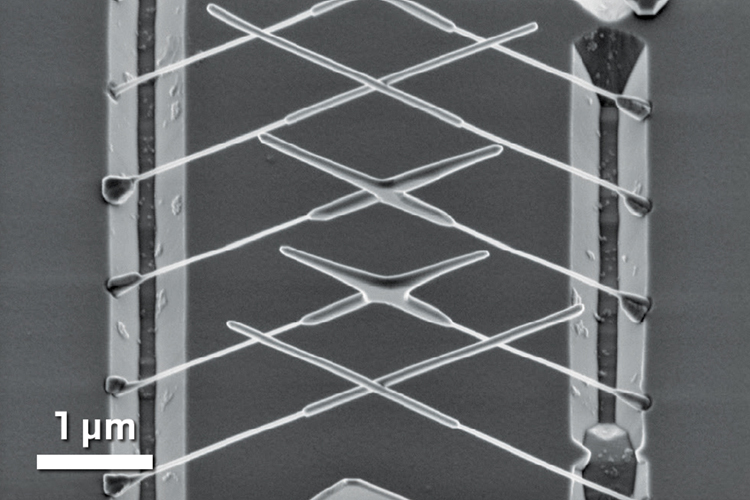
Topological materials
Advantages: By storing information in groups of electrons rather than in single electrons, topological materials should be relatively impervious to noise. In theory, topological qubits should have low error rates.
Status: Under development by Microsoft, Purdue University, Delft University of Technology, and others. The technology has not yet been demonstrated.
Making it weirder
Computers based on superconducting circuits or ions floating in a vacuum are already pretty strange. Some researchers see promise in even weirder quantum materials that might approach the ideal qubit.
In particular, researchers are excited about a class of qubits that might one day be made from so-called topological materials. Storing information in superpositions of quantum states, as is done in existing qubits, is “great but very susceptible to decoherence and loss,” says Michael Manfra, a materials scientist at Purdue University. The problem, he says, is that the leading designs store quantum information in a physical place—in one electron, for example. Topological materials store information nonlocally, in large clouds of electrons. If one electron in the cloud changes state, no matter. The rest of the group will maintain. “You do your best from the get-go to build a system that is tone deaf to the noise in the environment,” Manfra says.
Changing the quantum state of a topological material—all the electrons in its cloud—requires such a large input that it’s unlikely to happen by chance. Therefore, when the state of a qubit of this kind is measured, researchers can, in theory, have much more confidence that the answer is correct.
Researchers, however, are still figuring out how to make and use topological materials, let alone fashion a topological qubit, Manfra says. Topological materials are rare in nature, and those materials that do exist are difficult to work with. Strontium ruthenate, for instance, is brittle and obtainable only in small amounts—not good qualities for an electronic device. So Manfra and other researchers are investigating combinations of easy-to-work-with materials that, together, exhibit emergent topological physics. One design uses cryogenically cooled devices made by frosting the semiconductor indium arsenide with superconducting aluminum. This combo mimics the physics of a topological semiconductor, Manfra explains.
Although Manfra, who is collaborating with Microsoft, is excited by this work, he cautions that no one has made a topological qubit yet. But he’s optimistic. He thinks it’s possible researchers will demonstrate a topological qubit “in a couple years.”
Back to silicon
If a topological qubit can be made and lives up to its theoretical potential, it may make error correction easier—and quantum computers might need far fewer qubits than researchers have assumed. But given what’s been experimentally demonstrated so far, many physicists are not counting on this. They expect that running complex, error-corrected applications such as chemical simulations will require thousands or perhaps millions of nonideal qubits.
Some are skeptical that ion traps, superconducting qubits, and other designs will be amenable to that sort of scaling. This focus on scale has led some quantum engineers back to the material beloved by computer geeks the world over: silicon. Today’s computer chips are made up of billions of silicon-based transistors, integrated and controlled with metal wiring and manufactured at tremendous scales. Silicon transistors are powerhouses of binary computation. But very similar device designs can coax quantum effects from the same set of materials—with an isotopic twist.
Silicon spin qubits are built using wafers made from pure 28Si because it is “quiet.” The isotope has no nuclear spin, which cuts down on noise and improves coherence times. In this quiet environment, researchers can excite individual electrons and carefully control them. Researchers either add dopants such as phosphorus atoms—one of the approaches being pursued by a team at the University of New South Wales led by physicist Michelle Simmons—or apply voltages to trap single excited electrons in 28Si quantum dots, an approach being taken by Intel and CEA-Leti. Traditional transistors use metal gates layered with dielectrics to switch small patches of silicon between conducting and insulating states to represent 1 and 0. Silicon qubits can use the same gates and dielectrics to control individual electrons. By applying electric fields, researchers can switch the spin of a confined electron from up to down and back again.
The CEA-Leti group demonstrated a silicon spin qubit in 2016 (Nat. Commun., DOI: 10.1038/ncomms13575), and since then, silicon spin qubits have become a more popular research area. However, neither that group nor any others have been able to get large numbers of silicon qubits working together to perform basic quantum logic.
“Silicon qubits are compelling but behind as a technology,” says James Clarke, director of quantum hardware at Intel; his team is developing both silicon and superconducting qubits. When asked whether manufacturing conditions for silicon qubits need to be even more stringent than those for making conventional silicon transistors, CEA-Leti’s Vinet says, “You’re pressing where it’s painful—we don’t know.” This qubit design is still being characterized, and Vinet says researchers are still gathering data about how these qubits behave.
Clarke’s team at Intel is trying to speed up this research. At the American Physical Society Meeting in Boston earlier this year, Clarke described Intel’s strategy. Instead of testing one chip at a time in a helium refrigerator, Intel’s team has worked with Finnish equipment makers Bluefors and Afore to build a cryogenic probe station that can characterize an entire 300 mm wafer of spin qubit chips simultaneously.
Even though today’s quantum hardware is far from ideal, Peter Love, a physicist and quantum information scientist at Tufts University, still believes that we’ll soon reach quantum supremacy. “It’s very easy to imagine a 49-qubit device becoming impossible to simulate with a classical computer,” he says.
However, quantum supremacy is a moving target—the prospect has been a goad to classical programmers, who keep making their simulations better. A particularly devastating takedown published in July 2018 by 18-year-old Ewin Tang showed that classical computers can carry out one of the major classes of algorithms that had been held up as a sterling example of something only quantum computers would be able to perform (arXiv 2018, arXiv:1807.04271). She was an undergrad at the University of Texas at Austin at the time and is now a PhD student in theoretical computer science at the University of Washington.
But qubit designs are getting better too. At the moment, state-of-the-art quantum computers capable of performing calculations use tens of qubits. Google claims to be able to control 72 superconducting qubits with low error rates; other companies’ claims are more modest, in the range of 20 to 50 of the devices. The next landmark is to get around 100 qubits working together in a chip or device and then combine many of these systems to make bigger, more complex ones.
“The first system that makes that breakthrough will be the main platform for a long time,” Duke’s Brown predicts.
But there’s no telling which platform that will be. Many designs have been proposed. And it’s possible that ion traps and superconducting qubits will run into some major roadblock on the way to larger systems, one no one has anticipated. “If those don’t work,” Love says, “there’s a list to go down” for other solutions.

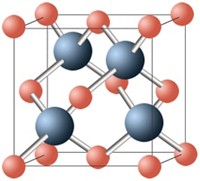
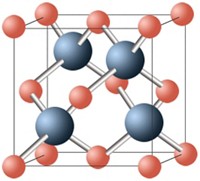
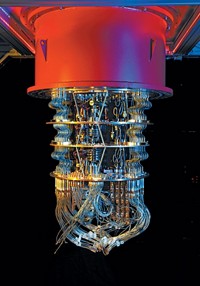

Join the conversation
Contact the reporter
Submit a Letter to the Editor for publication
Engage with us on Twitter